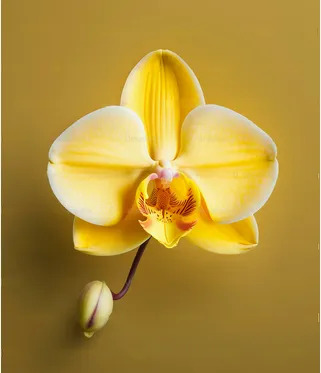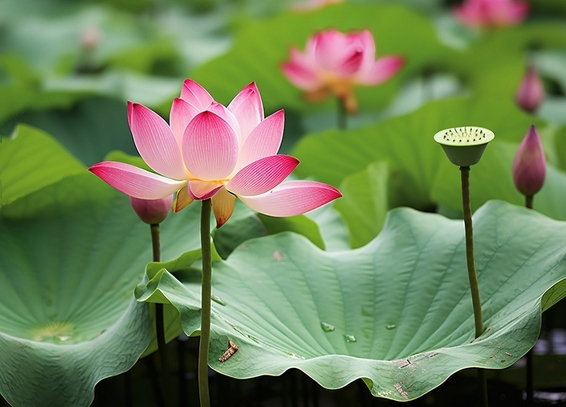Orchids are a diverse and widespread family of flowering plants, scientifically known as Orchidaceae. With over 25,000 species and more than 100,000 hybrids, orchids are one of the largest families of plants in the world. They are admired for their unique, intricate flowers, which come in a vast array of shapes, sizes, and colors. Orchids are found in almost every habitat on Earth, from tropical rainforests to tundra regions, making them incredibly adaptable and varied.
1. Botanical Characteristics
- Structure: Orchids have a highly specialized flower structure, with three petals and three sepals that can take on numerous forms. One of the petals, known as the labellum or lip, is usually highly modified and larger, often serving as a landing platform for pollinators.
- Roots: Many orchids, particularly tropical species, are epiphytes, meaning they grow on other plants rather than in soil. Their roots are thick, fleshy, and covered in a spongy tissue called velamen that helps absorb moisture from the air. Terrestrial orchids, on the other hand, grow in the ground and have more traditional root systems.
- Leaves: Orchid leaves vary in size, shape, and thickness depending on the species. Epiphytic orchids often have thick, leathery leaves to conserve water, while terrestrial orchids may have thin, soft leaves. Some orchids shed their leaves during dormancy.
- Flowers: Orchid flowers are highly specialized for pollination. Their shapes, colors, and fragrances have evolved to attract specific pollinators, such as bees, butterflies, moths, birds, or even bats. Orchids also exhibit bilateral symmetry (mirror image on both sides), and some flowers resemble insects to attract pollinators.
2. Habitat and Distribution
Orchids can be found all over the world, with the majority of species thriving in tropical and subtropical regions. Their distribution includes:
- Tropical Rainforests: Many orchids, especially epiphytes, are native to the rainforests of Central and South America, Southeast Asia, and Africa. These orchids grow on tree branches, taking advantage of the moist and humid environment.
- Temperate Regions: Orchids also grow in temperate climates, including parts of Europe, North America, and East Asia. Terrestrial orchids like Lady’s Slipper Orchids (Cypripedium) are common in these areas.
- Deserts and Alpine Areas: Some orchid species are adapted to extreme environments, such as deserts or high-altitude regions. These orchids have specialized adaptations to survive in harsh conditions.
3. Types of Orchids
There are two main categories of orchids based on their growing habits: epiphytic and terrestrial.
- Epiphytic Orchids: These orchids grow on other plants or objects, such as tree trunks or rocks, and are common in tropical regions. They absorb water and nutrients from the air and rain through their roots. Examples include:
- Phalaenopsis (Moth Orchid): One of the most popular and widely cultivated orchids, known for its long-lasting blooms.
- Dendrobium: These orchids produce clusters of colorful flowers and are often grown as houseplants.
- Terrestrial Orchids: These orchids grow in the ground, with their roots anchored in the soil. They are more common in temperate climates. Examples include:
- Cymbidium: Known for its large, showy flowers, Cymbidium orchids are often used in floral arrangements.
- Bletilla (Chinese Ground Orchid): A hardy terrestrial orchid that grows in gardens and produces beautiful pink or purple flowers.
4. Reproduction and Pollination
Orchids are masters of adaptation when it comes to reproduction and pollination:
- Pollination Mechanisms: Orchids have developed intricate relationships with pollinators, including bees, butterflies, moths, birds, and even certain species of flies. Some orchids produce sweet fragrances to attract pollinators, while others mimic the appearance or scent of insects. For example, Bee Orchids (Ophrys) have flowers that resemble female bees, which tricks male bees into attempting to mate with the flower, resulting in pollination.
- Symbiotic Relationships: Orchids have a symbiotic relationship with specific fungi, known as mycorrhizal fungi. These fungi help the orchid seeds to germinate by providing them with essential nutrients from the soil, as orchid seeds lack sufficient food reserves to sprout on their own.
- Seed Production: Orchids produce millions of tiny seeds in a single seed pod, which are dispersed by wind. These seeds are so small they are almost dust-like, and their survival depends on their ability to land in a favorable environment with mycorrhizal fungi.
5. Cultural and Historical Significance
Orchids have been revered in many cultures throughout history:
- Symbolism: Orchids symbolize beauty, luxury, and strength. In ancient Greece, orchids were associated with fertility, and in China, they represent refinement and integrity. In Victorian England, orchids were seen as symbols of wealth and exoticism due to their rarity and beauty.
- Traditional Medicine: In some cultures, orchids have been used for medicinal purposes. For example, in traditional Chinese medicine, certain orchids are used to treat a variety of ailments, including respiratory issues and digestive problems.
- Orchid Collecting: Orchids have long been sought after by collectors for their rarity and beauty. During the 19th century, orchid collecting became a craze known as “orchidomania,” where wealthy individuals and botanic explorers would go to great lengths to acquire rare species.
6. Orchids in Modern Horticulture
Today, orchids are among the most popular and widely cultivated ornamental plants in the world. They are prized for their beautiful and long-lasting flowers, and many hybrids have been developed to enhance their aesthetic appeal and adaptability. Orchids are commonly grown as houseplants and can also be used in landscaping, especially in tropical and subtropical regions.
- Popular Cultivated Orchids:
- Phalaenopsis (Moth Orchids): These are among the easiest orchids to care for and are widely available in nurseries and grocery stores.
- Cattleya: Known as the “corsage orchid,” Cattleyas produce large, fragrant blooms and are a popular choice for floral arrangements.
- Vanda: These orchids are prized for their vibrant, colorful flowers, often in shades of blue, purple, and pink.

7. Growing and Caring for Orchids
Orchids are generally considered more challenging to grow than other houseplants, but with proper care, they can thrive and bloom for many years. Here are some essential tips for growing orchids:
- Light: Most orchids prefer bright, indirect light. Too much direct sunlight can scorch their leaves, while too little light can prevent them from blooming. Some orchids, such as Phalaenopsis, can tolerate lower light levels, making them suitable for indoor environments.
- Watering: Orchids should be watered sparingly but consistently. It’s important to let the roots dry out between waterings, as overwatering can lead to root rot. Epiphytic orchids, in particular, prefer their roots to be exposed to air, so using a well-draining potting medium like bark is ideal.
- Humidity: Orchids thrive in humid environments, typically between 50-70% humidity. Misting the plants or placing a humidity tray beneath them can help maintain proper moisture levels.
- Temperature: Orchids generally prefer warm temperatures, but they can tolerate a range of conditions depending on the species. Tropical orchids thrive in temperatures between 65-80°F (18-27°C), while some terrestrial orchids can survive cooler climates.
- Fertilization: Orchids benefit from regular fertilization during their growing season, typically every two weeks with a balanced fertilizer diluted to half strength. A common recommendation is to “fertilize weakly, weekly.”
8. Threats and Conservation
Many orchid species are under threat due to habitat destruction, over-collection, and climate change. As a result, conservation efforts are being made to protect wild populations and promote sustainable cultivation.
- Habitat Loss: Deforestation and land development are major threats to orchids, especially epiphytic species that rely on trees for their habitat.
- Illegal Trade: Some rare orchids are targeted by poachers and collectors, leading to a decline in wild populations.
- Conservation Efforts: Botanical gardens, orchid societies, and environmental organizations are working to conserve orchid species through habitat preservation, cultivation programs, and legal protection. Orchid seed banks and tissue culture methods are also being used to propagate endangered species.
9. Interesting Facts about Orchids
- Longevity of Blooms: Orchid flowers can last for weeks or even months, making them highly desirable as ornamental plants.
- Largest Orchid: The Grammatophyllum speciosum, also known as the “Queen of Orchids,” is the world’s largest orchid, with individual plants weighing up to 2 tons and flowers that can reach over 10 feet in length.
- Vanilla Orchid: One of the most economically important orchids is the Vanilla Orchid (Vanilla planifolia), which produces vanilla beans used in cooking and perfumery.
10. Conclusion
Orchids are one of the most fascinating and diverse plant families, captivating people with their intricate flowers, ecological adaptations, and cultural significance. Whether in the wild or as cultivated plants, orchids continue to enchant enthusiasts around the world


